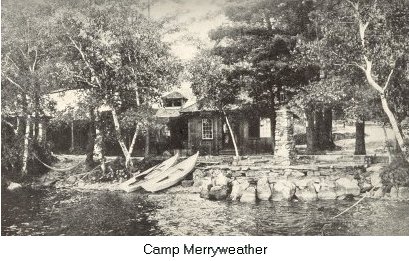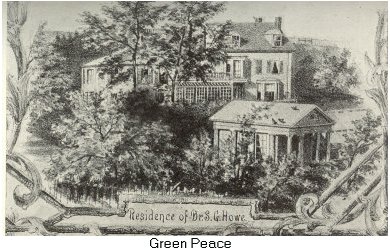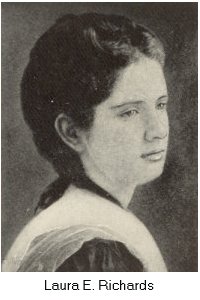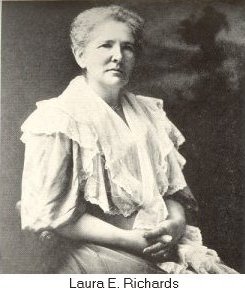
 Laura Elizabeth Richards was born February 27, 1850, at 74 Mount Vernon Street, Boston, Massachusetts, to distinguished parents and a home life that would early introduce her to the delights of language and fine arts as well as to a range of people and experiences. Her father, Samuel Gridley Howe, "a restless social reformer . . . [who] later gain[ed] fame as an abolitionist," [1] was also "the practical founder ... of the Perkins Institution and Massachusetts School for the Blind" in 1832. [2] Howe's star pupil -- and Laura's namesake -- was Laura Bridgman, a child who had been left blind and deaf after a bout with scarlet fever at age two. When Bridgman was seven, Howe met her and brought her to Perkins, where she became the first blind and deaf person to learn language and "finger spell." (Another Perkins student, Anne Sullivan, later taught Helen Keller.) Richards's mother, the poet Julia Ward Howe, is perhaps best known as the author of "Battle Hymn of the Republic." Laura was the youngest of four children: Julia, Florence (named for her godmother, Florence Nightingale), and Henry. A fifth child, Maud, was born a few years later, and a sixth, Sam, (who died of diptheria at age three), several years after.
Laura Elizabeth Richards was born February 27, 1850, at 74 Mount Vernon Street, Boston, Massachusetts, to distinguished parents and a home life that would early introduce her to the delights of language and fine arts as well as to a range of people and experiences. Her father, Samuel Gridley Howe, "a restless social reformer . . . [who] later gain[ed] fame as an abolitionist," [1] was also "the practical founder ... of the Perkins Institution and Massachusetts School for the Blind" in 1832. [2] Howe's star pupil -- and Laura's namesake -- was Laura Bridgman, a child who had been left blind and deaf after a bout with scarlet fever at age two. When Bridgman was seven, Howe met her and brought her to Perkins, where she became the first blind and deaf person to learn language and "finger spell." (Another Perkins student, Anne Sullivan, later taught Helen Keller.) Richards's mother, the poet Julia Ward Howe, is perhaps best known as the author of "Battle Hymn of the Republic." Laura was the youngest of four children: Julia, Florence (named for her godmother, Florence Nightingale), and Henry. A fifth child, Maud, was born a few years later, and a sixth, Sam, (who died of diptheria at age three), several years after.
The family moved to various homes in and around Boston during Richards's childhood. Among them were Green Peace, a house on five acres of land, and the Perkins Institution, where Howe, as Director, had one wing for the family's use.
When still quite young, Richards was introduced to languages through her mother's love of music. As she explained in her autobiography, Stepping Westward,
When we [children] gathered delightedly round the piano . . . we soon began to sing with [mother]. German songs, many of them brought back from Heidelberg by Uncle Sam Ward . . . sparkling French songs whose gayety was enchanting . . . Italian songs that flowed like water under moonlight; to say nothing of English and Scottish ballads without end.Richards grew up surrounded by books. Among the works she recalled reading as a child were Grimms' and Andersen's fairy tales, Ruskin's King of the Golden River, Thackeray's The Rose and the Ring, Alcott's Flower Fables, Catherine Sinclair's Holiday House, Irving's Tales of the Alhambra, Wolfert's Roost, and Sketch-Book, and Hawthorne's Wonder Book, Tanglewood Tales, Twice-Told Tales, and Mosses from an Old Manse (remarking of the latter two "These I read over and over, till I knew them almost by heart" [39]). She also read lighter fare -- The London Doll, The Country Doll, Tales from Catland, and various adventure tales by Mayne Reid. Years later, she recalled Reid's books with particular delight, writingWe never knew that we were studying French, German, Italian; that we were acquiring a vocabulary; that ear and voice were being trained by a past misterss in the management of both. (6)
For Brother Harry and me, there was none like him. We loved his dashing heroes and their amazing adventures. Two of them we took for our prototypes, and as Groot Willem and Henrik Von Bloom we hunted the borele, 'fiercest of the rhinoceroses,' or had 'a brush with the brindled gnu,' or thrilled at the sight of a black lion coming up the chimney.... Beside all this, Mayne Reid taught me most of the little I know about Natural History. (38)
She was also familiar with the works of Scott and Dickens, noting "they, with the Bible and Shakespeare, seem in memory a kind of foundation for everything else" (39). None too surprisingly, she also loved poetry, or, as she expressed it "I would rather read poetry than eat my dinner any day. It has been so all my life." She read Coventry Patmore's Children's Garland and Thalatta, as well as Elizabeth Barrett Browning, Whittier, and Tennyson; at "about thirteen," she began reading Shelley and Coleridge, and, later, Robert Browning, Rosetti, and Shelley. In reviewing her experiences with books, she wrote
My general idea, as I look back through the long years, seems to have been, "If you see a book, read it, especially if it is poetry!" My education would seem to stand on a solid (!) [sic] foundation of fairy stories, romance, and poetry, with more or less history tucked in here and there by way of mortar. (44-45)About 1863, the family moved to 19 Boylston Place, next door to the Richards family, whose youngest son, Henry, would later become Laura's husband. Although she had seen Henry at dancing school, the pair had not actually spoken; the situation changed some time after the move. As one source describes it,
The most memorable early contact with the family next door came when the Richards brothers helped extinguish a fire in the Howe house. [Her sister] Maud recalls Laura, flying down the stair to answer the violent ringing of the doorbell, 'her long, dark hair, a dusky veil, hanging about her.' She opened the door to find the five Richards brothers. From George in evening dress, 'I beg your pardon! Have you a fire here?' Politely from Laura, 'Yes, won't you come in?'She and Henry passed each other on the stairs carrying out possessions. [3]
 At seventeen, Richards accompanied her parents and sister Julia to Europe, visiting London, Rome, Venice, Athens, and Antwerp. In the winter of 1869, she became engaged to Henry Richards, by then a Harvard classmate of her brother's. They were married on June 17, 1871, the year he graduated from Harvard. The pair honeymooned in Europe because "[a]n architect, it was then thought, must know something of European architecture" (130), first stopping in England to see Richards' family, then travelling to Bruges, Ghent, Antwerp, Nuremberg, Innsbruck, Venice, Naples, Florence, Rome, Athens, Constantinople, and Milan.
At seventeen, Richards accompanied her parents and sister Julia to Europe, visiting London, Rome, Venice, Athens, and Antwerp. In the winter of 1869, she became engaged to Henry Richards, by then a Harvard classmate of her brother's. They were married on June 17, 1871, the year he graduated from Harvard. The pair honeymooned in Europe because "[a]n architect, it was then thought, must know something of European architecture" (130), first stopping in England to see Richards' family, then travelling to Bruges, Ghent, Antwerp, Nuremberg, Innsbruck, Venice, Naples, Florence, Rome, Athens, Constantinople, and Milan.
After their sojourn in Europe, the Richards returned to Green Peace, living there with Laura's parents and younger sister. Children and books came quickly. As Richards explained,
Four years saw the birth of the first three of my seven children, Alice, Rosalind, and Henry . . . I had always rhymed easily; now, with the coming of the babies, and the consequent weeks and months of quiet, came a prodigious welling up of rhymes, mostly bringing their tunes ... with them. I wrote, and sang, and wrote, and could not stop. The first baby was plump and placid, with a broad, smooth back which made an excellent writing desk. She lay on her front, across my lap; I wrote on her back, the writing pad quite as steady as the writing of jingles required. (155-56)
A number of those early rhymes, with illustrations by John Ames Mitchell, were then published in St. Nicholas.
During an economic downturn in the 1870s, her husband's business floundered. Henry's brother, Frank Richards, offered him a management position in the Richards's family's paper mill, and, in the summer of 1876, Laura and Henry Richards and their three children moved to Gardiner, Maine. They lived with various members of Henry's family for a time, then found "a square 'Colonial' house, with ell and barn, large chimneys, an open fireplace in every room, and even more important, an acre of lawn and garden" (251). Here, in the Yellow House (apparently so-named because the Richards soon replaced the brown exterior with yellow, a "warm, friendly pumpkin-color" [252]), four additional children were born: Henry, Julia Ward, Maud (who died circa 1885), and Laura Elizabeth II.
Richards's first book, Five Little Mice in a Mouse Trap was published in 1880, as was The Little Tyrant; two additional titles, Our Baby's Favorite and Sketches and Scraps (the latter illustrated by her husband), appeared the following year. The same decade saw additional publications, including retellings of folktales such as Beauty and the Beast and Hop o' My Thumb (both 1886), and both volumes about Toto (The Joyous Story of Toto [1885] and Toto's Merry Winter [1887]). 1889 produced Queen Hildegarde, which Richards described as "my first stumbling essay in books for girls" (369). This became the first of her Hildegarde series (about which she observed [circa 1930], "the later [volumes] are better written than the earlier ones; if I were twenty years younger I would write Queen Hildegarde over again" [324]).
The 1890s brought more girls books, including Captain January, perhaps now best known from the 1936 Shirley Temple movie. She also published several interrelated stories: Melody (1893), Marie (1894), Bethsada Pool (1895), Rosin the Beau (1898). (In an essay on Richards, Ruth Hill Viguers notes that "Rosin . . . is the son of Marie, the friend and benefactor of Melody, and [the teacher of] the fiddler at the dance" in Bethsada Pool.) [4a]
During the 1890s, Richards also added more volumes to the Hildegarde series, though she apparently had some problems with the second volume, Hildegarde's Holiday (1891), writing, in 1890, in a letter to a friend
Look here! I have written to see if Estes [the publisher] will let me off this Hildegarde thing till next year, putting Captain January in between. My dear, I have begun all wrong. Her ma never would have let them girls go stravaging [sic] across the country, with only a boy to take care of them. You know she wouldn't . . . [4b]She concluded the series with Hildegarde's Harvest in 1897, the same year she began the Margaret series, which continued into the next decade. Three Margarets, the initial volume, was, according to one reviewer, "conceived on a new plan. The Margarets are three cousins of the same name, -- one from the East, one from a ranch in the West, and one from a Cuban plantation, -- who come together for a summer's visit to an uncle whom they have never seen." Noting that "There is here an opportunity for contrast in character, which Mrs. Richards skillfully, but somewhat melodramatically, improves," the reviewer concluded that Three Margarets was "on the whole a charming little story, with a good deal of human nature in it" but that it lacked "the beauty" of Richards's Captain January. [5] In 1904, the Hildegarde and Margaret series were linked with the publication of The Merryweathers, which incorporated characters from both series. Although the two series are little known now (and Richards says little of them in her autobiography beyond the comments above and a mention that the Richards' Camp Merryweather was named after the book, not the reverse), both series were popular in their time and are fondly remembered by several early historians of children's literature. In Part III of A Critical History of Children's Literature, Elizabeth Nesbitt writes
There can be little doubt that in the books in Laura Richards' Queen Hildegarde series (1889- ) and Three Margarets series (1897- ) character, incident and situation are drawn from life. Even the delightful anecdotes told in Queen Hildegarde may have been heard by the child Laura Howe in summers spent in The Valley . . . To reread these books as an adult is to gain a deep appreciation of the impression made when they were read as a child; an impression made up not so much of the details of the story, but rather of halcyon days in the country, the delights of wood and stream and planted fields . . . of the inherent worth and dignity of simple, virtuous men and women; of the fun and frolic of a large family like the Merryweathers, each of them an individual and allowed to be so; of the give and take of family relationship; of the joy of good talk, free and spontaneous, permitted to drift as it pleases; and not least of all, the pleasure of meeting an old friend among books, like Robin Hood, best beloved of all Hildegarde's books . . . or the equal pleasure of being introduced to a new friend in literature, presented by one of Mrs. Richards' characters with that genuine enthusiasm which so successfully sells a book. [6]
Similarly, in "Laura E. Richards, Joyous Companion," Ruth Hill Viguers (also a co-author of A Critical History of Children's Literature) observes
I doubt if Mrs. Richards realized how widely these books were read and how generally loved. A paragraph from any of them, or even mention of the titles, brings to memory a picture of five girls thirty-odd years ago . . . relaxed in the late afternoon sunshine. . . In front of them are the wooded San Juan Islands . . . But their minds are on other scenes: a secret room under a stairway where a girl of another generation had put away her dolls; a young girl dancing in the moonlight or rescuing a selfish woman's jewels from a fire; a glamorous Cuban girl's romance and adventures during the Spanish-American War; the arrival in their new home of the ingratiating Merryweather family . . .And in 1932, in a review of another of Richards's books, the New York Times Book Review noted in passing that "The Queen Hildegarde stories still hold 13 and 14 year olds with their very real girl characters against a background of good breeding." [8]Alexander Woollcott . . . mentioned Anne Parrish's speaking of the 'peace' that the Hildegarde stories still brought her, and expressed surprise over the impression made on contemporaries by the wallpaper in Hildegarde's room. After forty years Kathleen Norris, whose childhood ambition had been to possess such a room, could still describe the wallpaper! [7]
While Richards was turning out books, her husband's family was strugging with the paper mill and the effects of technological change. As she explained, "By 1884 it became evident that if the Richards Paper Company were to live, its nature and its habitat must be changed. A pulp mill was built on the Kennebec at South Gardiner . . . and here the new industry -- new in this country; our mill being the first to introduce it -- was vigorously carried on. Sulphite pulp took the place of rags; instead of the long, echoing sheds, and the vats and 'rolls,' came 'digesters,' huge iron containers in which the spruce logs, carefully selected, were 'cooked' to pulp" (296). Disaster struck in 1893, when "on a winter's night, the pulp mill burned to the ground" (297). Although it was rebuilt, "the paper-making world [was] changing . . . like the shifts of a kaleidoscope, the great combination companies relentlessly strangling the small ones" (298), until, in 1900, the mill finally closed.

After some thought, the Richards family considered opening a small private school. Asked his advice, their friend, Reverend Endicott Peabody of Groton School, instead suggested a camp for boys. Henry remembered "a spot that greatly took his fancy; a strip of forest bordering on Belgrade Great Pond" (301), which the owner was persuaded to sell. Camp Merryweather (so named because in the Hildegarde and Margaret books, the Merryweather family spent their summers "at a Camp somewhat resembling [the one] at Cobbossee" [302]) opened 30 June 1900, and was still in operation 30 years later when Richards wrote her autobiography.
Richards was also active in designing activities for youth and in community affairs in Gardiner. In 1886, she created the Howe Club (named for her father), for her ten-year-old son Hal and his friends. The group met for ninety minutes on Saturday evenings. As Richards described it
I read to them -- first a poem, then Scott or Dickens for half the time; then there were apples -- or peanuts -- and games in many varieties, all with the pill of Information heavily sugar-coated. To give the boys something that school in its crowded curriculum could not give; to enlarge first their vocabulary and then their horizon; to show them the fair face of poetry; first and last to give them a good time; this was my ardent desire. (342)
 The Howe Club lasted for approximately 25 years. Additionally, Richards was involved in founding the Ten Times One Club (afterschool activities for children) and the Good Comrades Club (for young girls in the workforce). Her interest in lifelong education led to her involvement with the History Class (later the Current Events club); this was an adult study group, where she and her husband "studied with ardor; wrote our papers with passion and read them . . . before a neighborly, friendly audience" (340). [9] In 1895, she helped found the Women's Philanthropic Union (designed to correlate the activities of various women's organizations to avoid duplication of effort) and served as its president until 1921. She and her husband also were two of the founders of the Gardiner Library Association and participated in assorted fundraising activities for a library building (which her husband designed). [10]
The Howe Club lasted for approximately 25 years. Additionally, Richards was involved in founding the Ten Times One Club (afterschool activities for children) and the Good Comrades Club (for young girls in the workforce). Her interest in lifelong education led to her involvement with the History Class (later the Current Events club); this was an adult study group, where she and her husband "studied with ardor; wrote our papers with passion and read them . . . before a neighborly, friendly audience" (340). [9] In 1895, she helped found the Women's Philanthropic Union (designed to correlate the activities of various women's organizations to avoid duplication of effort) and served as its president until 1921. She and her husband also were two of the founders of the Gardiner Library Association and participated in assorted fundraising activities for a library building (which her husband designed). [10]
In the twentieth century, Richards continued to write children's stories and verse, including the two-volume Honor Bright series (Honor Bright: A Story for Girls [1920] and Honor Bright's New Adventure [1925]), and an unsuccessful sequel to Captain January (Star Bright [1927]). Her best-known collection of verse was Tirra Lirra: New Rhymes and Old from 1932 (reissued in 1955 with a preface by May Hill Arbuthot), which incorporated early verses, many of which had been published in children's magazines, along with new material. During this period, Richards also wrote biographies, some of family members or friends, including Florence Nightingale: Angel of the Crimea (1909), Two Noble Lives: Samuel Gridley Howe and Julia Ward Howe (1911), and Laura Bridgman: The Story of an Opened Door (1928). Richards and her sister Maud Howe Elliott co-authored Julia Ward Howe, 1819-1910 (1915), for which they received the Pulitzer Prize for biography in 1917. Her final book, What Shall the Children Read, was published in 1939; the following year, the Gardiner Public Library Association issued Laura E. Richards and Gardiner, a compilation of Richards' poems and articles which had been previously published in local newspapers.
Richards died on 14 January 1943.
Notes
[1] Jennifer K. Ruark, "Unearthing 'the Original Hellen Keller,'" The Chronicle of Higher Education, 6 April 2001. Online at http://www.connsensebulletin.com/keller.html
[2] Laura E. Richards, Stepping Westward (New York: D. Appleton and Company, 1932), 1. It shoud be noted that the webpage for The Perkins School for the Blind (formerly the Perkins Institution) cites 1929 as its founding date.
Stepping Westward, the second of Richards's autobiographies (the first, When I Was Your Age, was for children and was published by Estes & Lauriat in 1893), serves as the source for most of this essay and the images accompanying it. Citations for all future quotations from Stepping Westward are parenthetical in the text.
[3] Ruth Hill Viguers, "Laura E. Richards, Joyous Companion," pt. 1, Horn Book Magazine (April, 1956), 94. Quoted material within the passage is attributed to Maud Howe Elliott's Three Generations (Little, Brown & Company, 1923).
[4a] Viguers, pt. 3 (October, 1956), 383.
[4b] Laura E. Richards, letter to Elizabeth Thorndike Thronton. Quoted in Viguers, pt. 2 (June, 1956), 170.
[5] The Dial (16 December 1897), 401. Quoted in "Laura E. Richards," Children's Literature Review, vol. 54, 166.
[6] Cornelia Meigs, Anne Thaxter Eaton, Elizabeth Nesbitt, and Ruth Hill Viguers, A Critical History of Children's Literature, rev. ed. (New York: Macmillan Publishing Co., Inc., 1969) , 351.
[7] Viguers, pt. 3, 380-81.
[8] Review of Tirra Lirra. NYT Book Review (23 October 1932), 13. Quoted in CLR, 169.
[9] Viguers credits her with founding this club (pt. 2, 173).
[10] Viguers, pt. 2, 171-73.
Copyright 2002 - Deidre Johnson
Return to main page